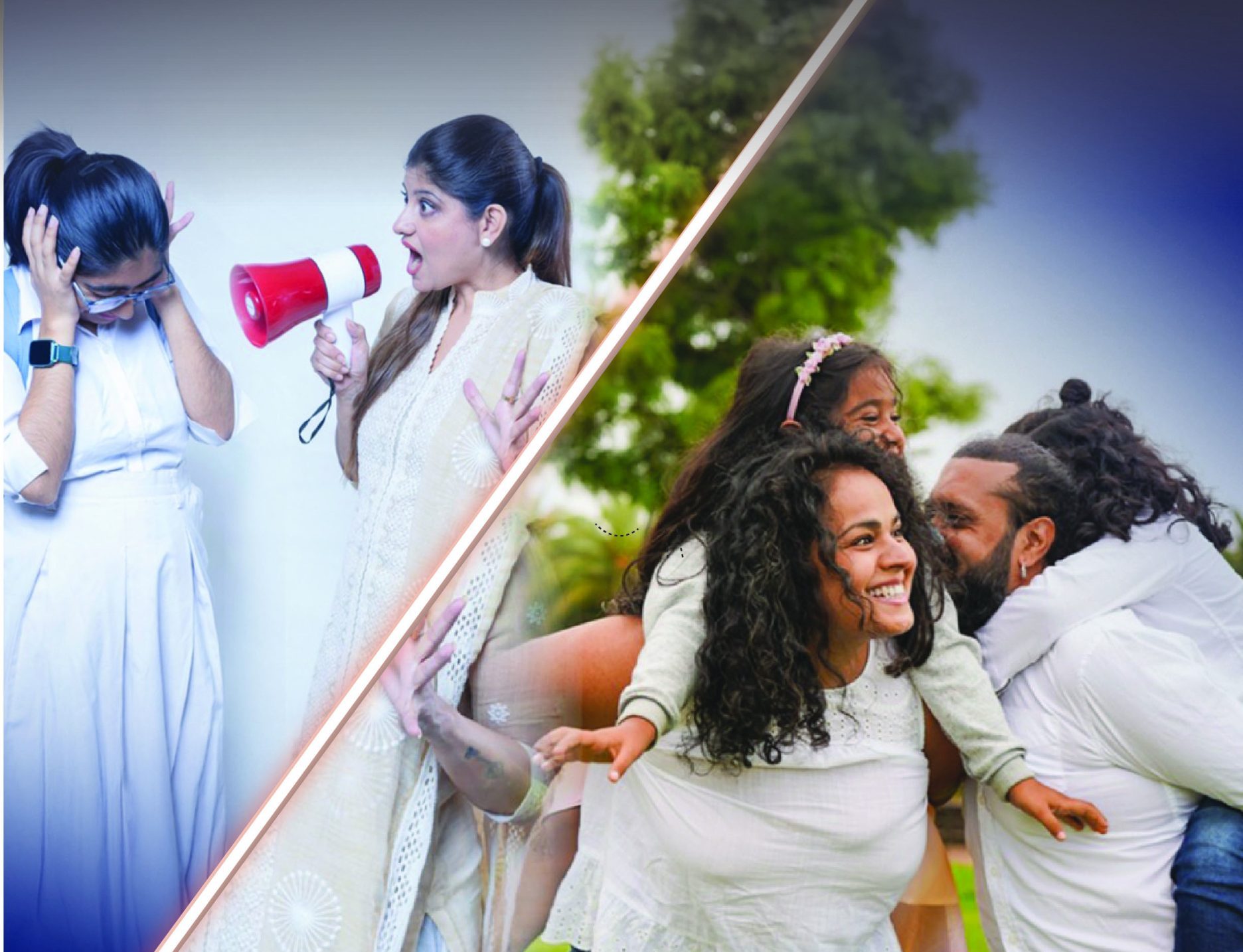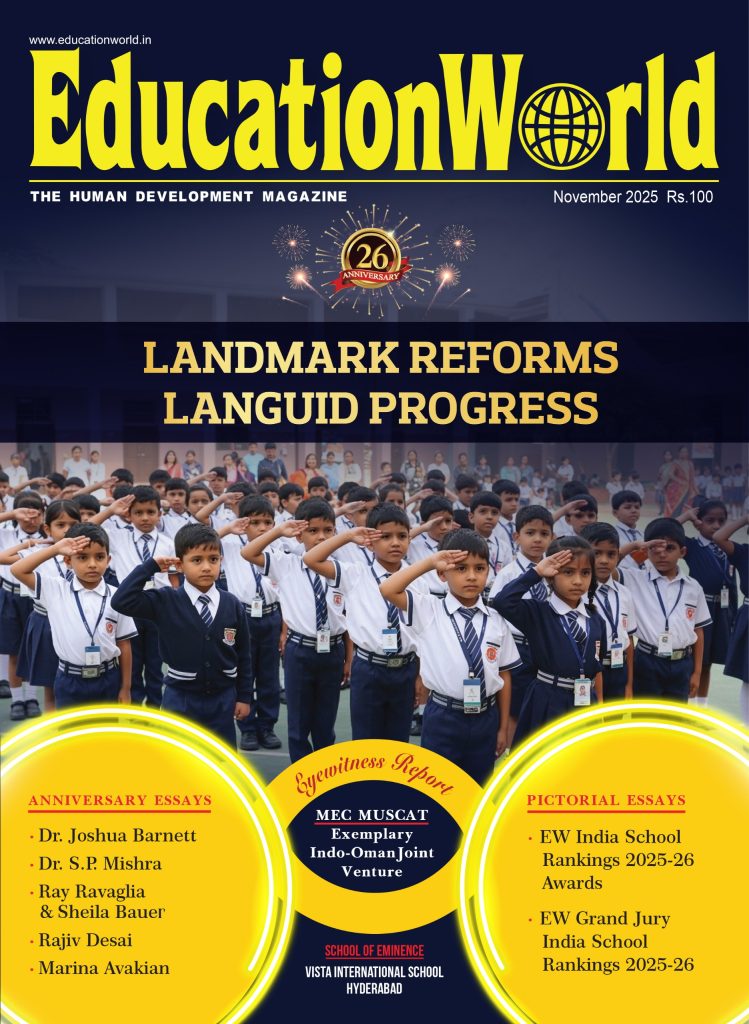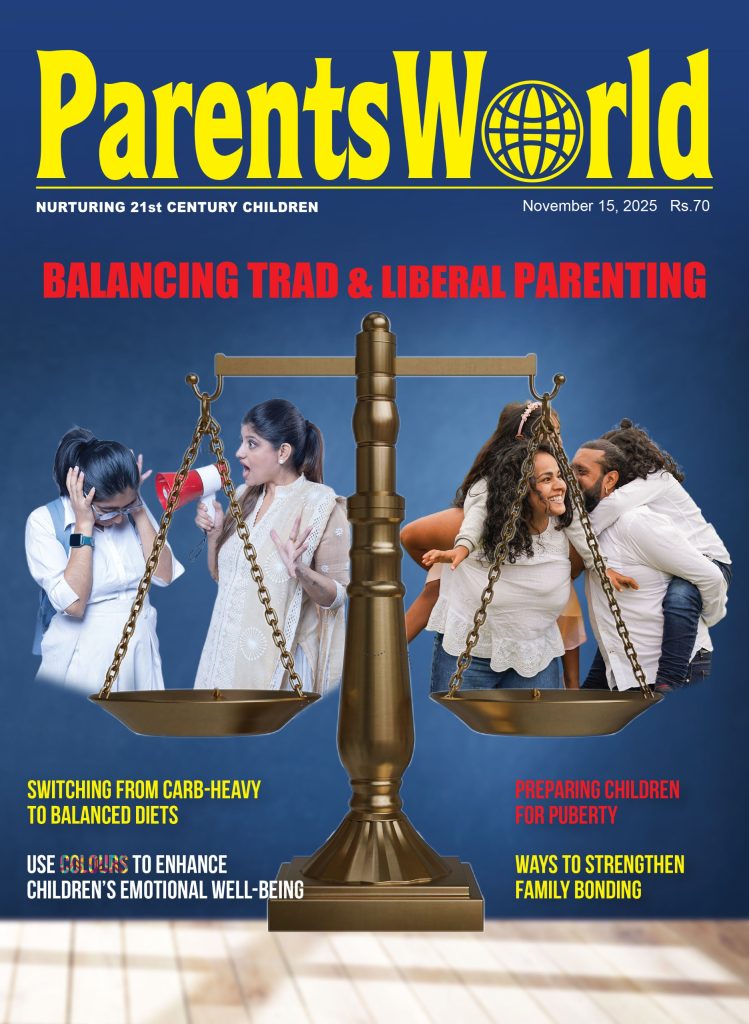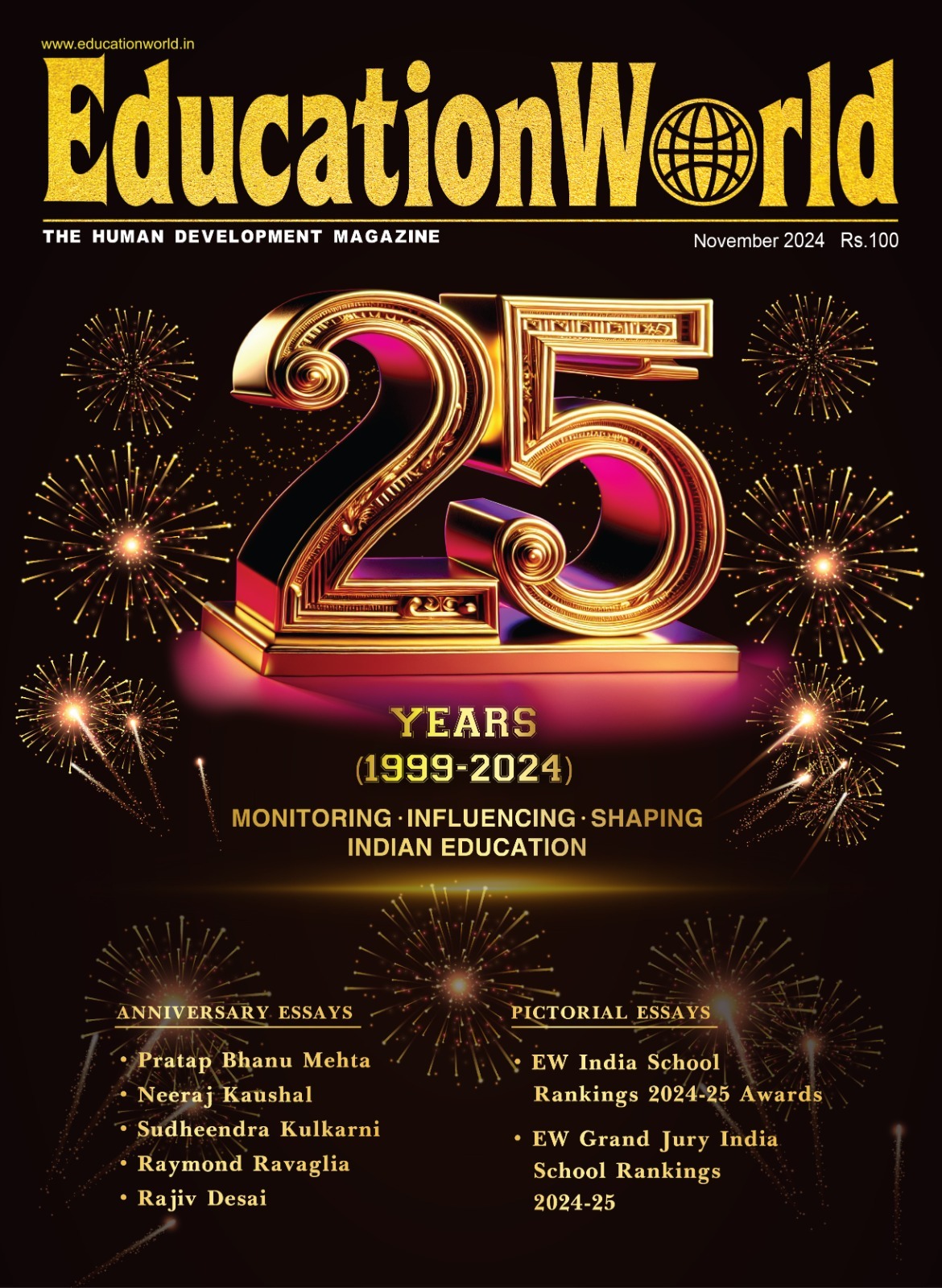Balancing traditional & liberal parenting
21st-century realities have rewritten parenting rules. With fewer trusted elders to turn to, parents now rely on digital advice and online communities. In this new age, children need the best of both worlds — parenting styles that integrate traditional wisdom with modern liberal parenting
Kiran Balimane & Cynthia John
 Twenty-five years ago the dawn of the new millennium was a time of global optimism. It was a moment of renewed global commitment to human development, with special focus on children’s education, health, and well-being. In September 1999, the international community — represented by 189 member states of the United Nations — convened at United Nations headquarters in New York to adopt the United Nations Millennium Declaration.
Twenty-five years ago the dawn of the new millennium was a time of global optimism. It was a moment of renewed global commitment to human development, with special focus on children’s education, health, and well-being. In September 1999, the international community — represented by 189 member states of the United Nations — convened at United Nations headquarters in New York to adopt the United Nations Millennium Declaration.
This declaration marked one of the most ambitious global efforts in human history to address poverty and inequality. At the heart of this commitment were the Millennium Development Goals (MDGs) — a set of eight time-bound goals to be achieved by 2015. They collectively aimed to improve living conditions for all, especially children and vulnerable populations. The second MDG-2 explicitly committed all signatory nations to “achieve universal primary education” ensuring that “all boys and girls complete a full course of primary schooling.”
This optimism proved contagious. EducationWorld — The Human Development Magazine was launched in November 1999 as India’s — perhaps Asia’s — first education news magazine with the mission statement to “build the pressure of public opinion to make education the #1 item on the national agenda.” Three years later in December 2002, India’s Parliament amended the Constitution (86th Amendment Act) making it obligatory for the State to provide free and compulsory primary education for all children (aged six-14).
Meanwhile within relatively well-off, upwardly mobile middle classes around the world, a related debate on best ways and means to educate and nurture children to take on the increasingly complex challenges of the 21st century gathered momentum. In 2011, Amy Chua, an ethnic Chinese professor of the top-ranked Yale Law School, USA, stirred a global debate on discipline-based “Chinese parenting” with publication of her book Battle Hymn of a Tiger Mother. In the book Chua contended that tough disciplinarian parenting produces more successful and resilient children than the permissive, self-esteem-focused “Western parenting”. This ‘tough love’ parenting style demands top scores in class and board exams and hours of forced music and sports practice. Battle Hymn was widely condemned in the US and the West as too harsh, bordering on “abusive”.
According to Chua, parents who demand excellence, enforce discipline, and allow children few choices, develop their children’s perseverance, focus, and a sense of mastery. Conversely she was critical of American liberal, permissive-style parenting which in her opinion breeds mediocrity. She contrasted her approach with Western parents’ over-concern for children’s self-esteem and happiness, claiming it results in entitled under-achieving children and later adults.
This book perhaps explains the spectacular rise of the People’s Republic of China (PRC) to pole position in the global community of nations. As recently as 1978 China’s GDP was on a par with India. Since then it has ballooned to $20 trillion cf. India’s $4.5 trillion. Be that as it may, Battle Hymn was a runaway bestseller in the US with an estimated sale of 2 million copies worldwide and sparked a global debate on what parenting style is best for children in this complex and challenging day and age.
In India, a patriarchal society for centuries, all major decisions — including education, marriage and career choices — continue to be made by authoritarian Tiger Dads. Liberal, nurturing and enabling parenting is a recent post-liberalisation (1991) phenomenon. The quick growth and expansion of the middle class to over 430 million after the rigidly controlled Socialist economy was liberalised and deregulated in 1991, has belatedly awakened society to the issue of children’s happiness and mental and emotional well-being. Nevertheless such liberal parenting is still confined to the relatively well-off upper middle class. Within the rest of the population, children do as they are told by usually ill-informed parents and stern patriarchs.
Certainly, during the past few decades, the middle class Indian family has undergone a radical transformation. The joint family system has steadily given way to nuclear households which have risen from 50 percent in 1981 to 58.2 percent in 2019-21, according to the National Family Health Survey 5. As a result, the average household size has shrunk from nearly seven members in the 1960s to just over four today, with an increasing number of urban families identifying as DISK (Double Income Single Kid) or DINK (Double Income No Kids).
This seismic social transformation — fewer children, dual-income households, the pervasive influence of social media, and evolving gender role mindsets — has reshaped parenting. Millennial couples are increasingly questioning traditional hierarchies and discipline-driven parenting and increasingly opting for more communicative, empathetic, and child-centric parenting. Yet, simultaneously in this new age of instant communication and digital overload many middle class parents are also rediscovering the value of traditional parenting — discipline, respect for elders, and cultural grounding.
The result is a generation of parents in flux — intent upon preserving traditional, cultural values while embracing modern ideals of open, liberal parenting. But in trying to strike the perfect balance, many parents swing from one extreme to the other, uncertain about nurturing children coming of age in the VUCA (volatile, uncertain, complex and ambiguous) and/or BANI (brittle, anxious, nonlinear, incomprehensible) era. Indeed, most continue to replicate parenting they experienced as children, over-emphasising obedience and authority.
But 21st-century realities have rewritten parenting rules. With fewer trusted elders to turn to, parents now rely on digital advice and online communities. In this new age, children need the best of both worlds — parenting styles that integrate traditional wisdom with liberal, modern parenting. The emerging consensus is that Generation Alpha (children born after 2010) in particular needs parenting that carefully amalgamates traditional, cultural values with liberal, enabling tenets that ensure children’s emotional and mental well-being.

Nivedha M
“In the new digital age, children are influenced not only by family but by peers, media influencers, technology, and global culture. If parents lean only on tradition, children are likely to become disconnected from the contemporary cultural world. If they practice modern liberal parenting, children may lose touch with their heritage, roots and values. Contemporary parents need to mix and match, hold on to legacy cultural values and traditions while adopting the empathy, communication, and openness of liberal parenting. When the right balance is struck, children will grow into emotionally confident and resilient young adults,” says Nivedha M, a Puducherry-based child psychologist.
However, as new influences — global media, peer culture and digital lifestyles, especially social media — shape parents and children, the balance is tilting increasingly toward modern, liberal parenting. A growing number of middle class parents, eager to raise independent children who can succeed in the VUCA world are inadvertently letting go of the cultural anchors and discipline that once grounded family life. In the rush to keep pace with contemporary ideals of freedom, self-expression, and child autonomy, a rising number of parents are becoming permissive. As a result, some parenting experts believe that Generation Alpha is gradually losing touch with its cultural roots and becoming increasingly disconnected with Indian traditions and family values.
“Teaching children about family traditions, customs, and values is not regressive, but essential for children’s orderly emotional development. Celebrating Indian culture, festivals and family rituals, and involving children in weddings and community events nurture healthy pride in their culture and roots. These experiences build children’s emotional foundation, respect for elders, and appreciation of heritage. When such cultural grounding is balanced with the openness and confidence that modern parenting encourages, it nurtures well-rounded children — rooted yet adaptable, respectful yet independent,” says Dr. Monica Nagpal, a Hyderabad-based psychologist, parenting coach, and founder of hopeandhappiness.com.

Poulami Sarker
Kolkata-based Poulami Sarker, parenting coach, career strategist, and emotional intelligence educator and founder-CEO of Dreams EdTech, highlights important features of traditional and modern parenting. According to her, traditional parenting propagates the virtues of respect, obedience, discipline, family bonding, and inherited values. On the other hand, latter-day evolved parents encourage individuality, equality, empathy, and independent thinking. “Both styles have their positives and negatives. Therefore children interests are best served by intelligent integration of both styles,” says Sarker.
Elaborating, Sarker suggests ways and means to balance traditional and modern parenting styles:
Combine discipline with empathy. Traditional parenting is based on obedience, and enforcement of discipline with children expected to accept punishment and rewards unquestioningly.
Liberal parents heed children’s voices and opinions. They lean toward permissiveness with desire to create an understanding and friendly home environment.
Prescription. Make it clear that some rules are non-negotiable (such as personal safety), and provide children with the reasoning behind rules. Remain open to suggestions and exhibit empathy when children provide reasons for not following a rule. The objective should be to encourage self-discipline rather than blind obedience. Remain firm about boundaries that matter — safety, respect, and responsibility. Simultaneously, be flexible in areas where children can make choices, such as how they spend their leisure time. Discuss and set rules democratically en famille. Once rules are set, enforce them consistently so that children learn about freedom with accountability.
Festivals/family rituals. In Indian culture, dining together, celebrating festivals, prayer time, and storytelling from folklore are integral to family life. Children are expected to follow traditions built around festivals and everyday rituals.
However, latter-day educated parents are more flexible about how children celebrate festivals and follow traditions. They are encouraged to explore diverse cultural practices and modify/adapt customs they personally enjoy.
Prescription. Encourage children to actively participate in family festivals and customs and explain their significance and origin. Share your own childhood experiences and the joy associated with cultural traditions. However in this day and age include new rituals, celebrations that reflect your children’s interests and their evolving world. If they’re reluctant to follow certain traditions, find alternatives. This way, family rituals can evolve naturally — remaining rooted in heritage while adapting to changing times.
Education/academics. Indian parents set high value on academic achievement. Scoring high marks is widely believed to be every child’s main responsibility, because education is linked to children’s future security and social standing. But it’s noteworthy that enforcing discipline and ambition in children also prompts stress, pressure, and often aptitudinally erroneous career choices, made to please parents.
Liberal, well-educated parents concede children greater freedom to explore a wider range of interests beyond academics. They value creativity, critical thinking, and emotional intelligence, even if this results in lower test scores.
Prescription. Celebrate academic success while also acknowledging the importance of all-round holistic development of children. Therefore, co-curricular and extra-curricular education should also be encouraged. Help children set realistic goals, prepare study schedules, and budget time for performing arts and sports education. Teach them to give their best — whether it’s an exam, a music recital, or a football match. This develops children’s resilience and self-regulation, teaching them that learning in all its forms — academic or otherwise — is equally valuable.
Technology use. In traditional homes, smartphones and new digital technologies are tolerated as necessary evils. However Gen Z (born in the new millennium) and Gen Alpha (born after 2010) children are digital natives who need new technologies for education, socialisation and recreation. Parents should encourage digital media usage for research, online classes, and entertainment. The tricky bit is to ensure that children are monitored to prevent overuse of digital media for entertainment. Therefore, parents should teach children to use digital devices/media mindfully.
Prsecription. Encourage them to explore educational skill-based websites and videos, use digital media to enhance their creativity and problem-solving, not merely for entertainment. Set clear time limits for digital media screen time use and designate “tech-free family hours” — such as during meals or weekend mornings — to reinforce the value of in-person communication.
Respect for elders. In Indian society respect for elders is a valued cultural legacy. Even to this day, children are admonished for questioning rules and diktats of elders/authority figures with obedience equated with good manners.
However, times have changed and more evolved parents acknowledge that respect should be mutual and that they need to listen to children’s points of view, encourage dialogue, and value independent thinking.
Prescription. Teach children that respect is a two-way street — it requires development of listening skills, empathy, and courtesy, regardless of age. Teach children to express opinions politely and disagree respectfully. Model this behaviour while communicating with your elders, teachers, household help. At the same time, remind children that experience deserves consideration and that conversations/debates can be conducted without acrimony and rudeness. This is a very important skill which is not emphasised in education institutions or at home.
Personal safety. Inevitably parents worry about the safety of their children and often set strict rules about where children can go, whom they visit, and when to return home. Authoritarian parents closely monitor children’s movements and often tend to impose restriction, arbitrarily and illogically.
Latter-day parents understand that childhood should be a joyful rather than fearful, experience. Therefore, they allow children greater freedom to socialise with peers and relatives, both online and offline.
Prescription. Self-evidently, the best parenting practice is to combine prudent vigilance with open parent-child communication. Advanced technology should be invoked — tracker apps, location sharing, CCTVs — to ensure children’s safety. Discuss personal safety risks with children in age-appropriate language, highlighting online dangers, sexual boundaries, and peer pressure. Encourage them to speak freely about uncomfortable experiences or questions related to sex, dating, or exposure to inappropriate content. Teach them how to remain alert, handle unsafe situations, and memorise emergency helpline numbers.
 Traditional vs. Latter-day parenting
Traditional vs. Latter-day parenting
Traditional
- Highest value to respect, obedience, discipline, family bonding, culture
- Authoritarian — no questions parenting style
- Emphasis on culture, traditions and family
- Limited use of technology
- Strict rules, decision-making by adults
Modern-liberal
- Accords high importance to children’s individuality, freedom, equality, empathy and independent thinking
- Democratic, egalitarian parenting
- Emphasis on individual, holistic personality development
- Encourage use of technology for balanced learning and entertainment
- Egalitarian, open to suggestions, and respectful of children’s opinions
 Are you a traditional or modern-liberal parent
Are you a traditional or modern-liberal parent
Latter-day, evolved child-rearing requires balancing traditional disciplinarian with liberal, open-minded parenting. However, balancing household discipline and order with progressive, liberal parenting is easier said than done. All parents lean towards one style or the other.
Here are some pointers to assess which parenting style you lean towards:
Independence. Modern parenting accords great importance to nurturing independent children. For instance, it’s normative in the West for infants to sleep in a separate bedroom from early age with teens often moving out of the family home after they mature. On the other hand, traditional parents tend to be more controlling in the best interests of their children. For instance, in Indian families, it is not unusual for youth to live with their parents until they are married and even after that in joint families.
In households that follow modern parenting tenets, individualism and independence are viewed as positive, laudable traits. In contrast, traditional parents expect obedience and co-operation.
Academics. Traditional parents demand good academic learning outcomes. Indeed not a few of them believe children’s high academic scores are proof for successful parenting. On the other hand, modern liberal parents tend to prioritise holistic, enjoyable education and don’t push children too hard. They have greater awareness that academic toppers don’t necessarily become successful professionals.
Decision making. Too often, traditional parents make decisions for their children — beginning from how much and what to study, career decision and choice of marriage partner. In her book, Beyond the Tiger Mom: East-West Parenting for the Global Age (2016), Chennai-based education consultant Maya Thiagarajan cites the example of a young Indian mother justifying academic pressure. “I feel I am doing my duty when I make my daughter study hard, because then I know that I am helping her learn and succeed. It’s when I don’t make my child do extra work that I feel terribly guilty.”
Conversely in modern parenting households, children are encouraged to express their opinions and take independent decisions relating to subjects of study, career choice and increasingly, marriage.
Punishment. It’s common for traditional parents to use punishment, including corporal punishment, against “disobedient” children. However, for parents practicing modern parenting, physical punishment in home environments is verboten. But it is common to ‘ground’ children as punishment wherein they are not allowed to go out, meet friends or play for a specified period.
Give and take. Traditional parents are known to make huge financial and personal sacrifices to provide for their children, and expect their offspring to care for them in their old age. Modern parents prefer to focus on children’s personal fulfilment and the pursuit of happiness.
Leisure/enjoyment. Modern parents allow children time for friends and social events. Traditional parents think twice before letting their child attend a birthday party as they feel more useful things can be done with that time.





 Traditional vs. Latter-day parenting
Traditional vs. Latter-day parenting Are you a traditional or modern-liberal parent
Are you a traditional or modern-liberal parent










Add comment